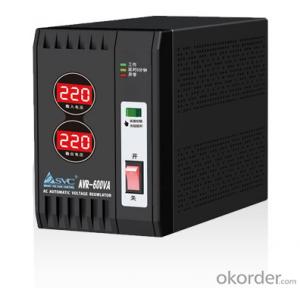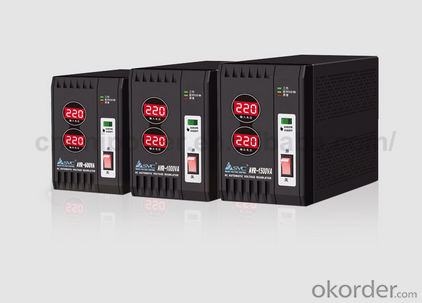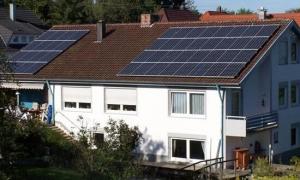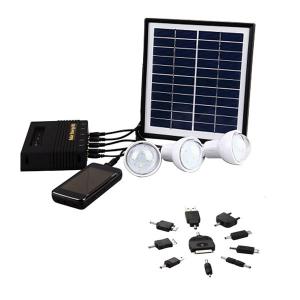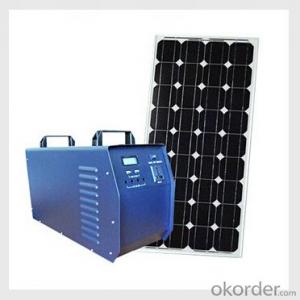Stabilizer High-efficiency Egypt AC Power Voltage Stabilizer
- Loading Port:
- China main port
- Payment Terms:
- TT OR LC
- Min Order Qty:
- 20 carton
- Supply Capability:
- 10000 carton/month
OKorder Service Pledge
OKorder Financial Service
You Might Also Like
Egypt AC Power Voltage Stabilizer 
Product Description

| Model | AVR-600VA | AVR-1000VA | AVR-1500VA |
| Rated power | 600VA | 1000VA | 1500VA |
| INPUT | |||
| Input voltage range & frequency | 160~280VAC/Same as AC | ||
| OUTPUT | |||
| Output voltage range | 220VAC±10% | ||
| DISPLAY | |||
| LED digital display status | Input voltage, output voltage | ||
| LED display status | Normal, Display, Fault | ||
| PROTECTION | |||
| Protections | Over & low voltage, overload, high temperature, short circuit protection | ||
| ENVIRONMENT | |||
| Environment of performance | Temperature 0℃~40℃, Humidity 20%~90% | ||
| Noise level | Less than 40dB | ||
| PHYSITAL | |||
| (kg) / Net weight (kg) | 2.3 | 2.9 | 3.6 |
| (mm) / Unit dimention (mm) | 205*108*157.5 | ||

1. Wide range of input voltage
The UPS can offer normal and stable service voltage under its input voltage range. When the input voltage is out of its range the machine will switch to battery mode automatically to keep the output power in order to protect the equipment, such as computers, ensure they will not be damaged by the over high or over low voltage, users can continue the operation of equipment for a while or save the data on computers while the power network is abnormal.
2. Wide range of AVR(Automatic voltage regulation)
In the product’s input voltage range and under 3 steps of intelligent AVR function, it can provide a stable output voltage.
3. Automatic self detection when UPS on(LED).
Before the UPS on, red, yellow, blue LED will light up two times by cycle turns, after self detection UPS switch to AC mode/battery mode or working mode.
4. Silence function
In the "battery mode", shortly press the switch to turn off the buzzer. But the battery is about to run out or the load is too heavy, the buzzer sound cannot be muted.
5. Overload protection
In the battery mode, output voltage turn down correspondingly when it is overload, after the capacity of load is lower than the rated power then output voltage will back to rated value, it ensures the UPS will not shut down by abrupt overload which caused by surging current during the computer is working and other equipment is added.
6. Short circuit protection
When the mis-operation caused the load short circuit or computer failure (such as power tube breakdown of switch) cause short circuit, the UPS will shutdown automatically for protection.
7. The low current switch
This UPS adopts low current switch to extend the service life which is longer than conventional battery and high current switch in AC current path.
8. Automatic charging
There are two charging mode, charging time is faster than ordinary charging mode, higher efficiency, and greatly prolonging the service life of the battery.
9. With a bypass output
Independent bypass output socket for external printers or scanners of computer peripherals, with surge protection of the load.
- Q: Can solar energy systems be used in areas with limited access to social services?
- Yes, solar energy systems can be used in areas with limited access to social services. Solar energy systems are a decentralized and standalone source of electricity, which means they can be installed and operated independently. This makes them suitable for remote or underdeveloped areas where access to social services, including reliable electricity, may be limited. Solar energy systems can provide a sustainable and affordable solution for generating electricity, powering essential services such as lighting, water pumps, and communication devices, thereby improving the quality of life in these areas.
- Q: How do solar energy systems impact the reliability of the electricity grid?
- Solar energy systems can positively impact the reliability of the electricity grid by diversifying the energy sources. As solar power is a renewable and abundant resource, it can help reduce reliance on traditional fossil fuel-based power generation, thereby enhancing grid stability. Additionally, distributed solar installations can reduce strain on the transmission infrastructure and decrease the risk of blackouts by providing power closer to where it is consumed. However, intermittent nature of solar energy may require effective grid management and energy storage solutions to ensure consistent power supply during periods of low sunlight.
- Q: How do solar energy systems affect the aesthetics of a building?
- Solar energy systems can have both positive and negative effects on the aesthetics of a building. On one hand, solar panels can be seen as a sleek and modern addition to the design, adding an eco-friendly and futuristic appeal. Additionally, some solar systems can be integrated seamlessly into the architecture, enhancing the overall visual appeal. On the other hand, bulky or poorly placed solar panels may detract from the building's aesthetics, especially in historic or highly stylized structures. However, advancements in solar technology have led to more aesthetically pleasing options, such as solar tiles or transparent panels, which blend better with various architectural styles. Ultimately, the impact on a building's aesthetics depends on the design, placement, and integration of the solar energy system.
- Q: What are the advantages of using solar energy systems?
- There are several advantages of using solar energy systems. Firstly, solar energy is a renewable and sustainable source of power, meaning it will never run out. Secondly, using solar energy reduces dependence on fossil fuels, which helps mitigate climate change and air pollution. Additionally, solar energy systems require minimal maintenance and have a long lifespan, resulting in cost savings over time. Finally, solar energy systems can provide energy independence and stability, especially in remote areas where access to traditional power grids may be limited.
- Q: Can a solar energy system be installed on a library or educational institution?
- Yes, a solar energy system can be installed on a library or educational institution. In fact, many libraries and educational institutions have already embraced solar energy as a sustainable and cost-effective solution for their energy needs. Installing a solar energy system on a library or educational institution not only helps reduce electricity costs but also demonstrates a commitment to clean energy and environmental responsibility. Libraries and educational institutions often have large rooftops or open spaces that are ideal for installing solar panels. These panels can be mounted on the roof or on the ground, depending on the available space and structural considerations. Additionally, solar panels can also be integrated into building materials such as windows or walls, allowing for more creative and aesthetically pleasing installations. By installing a solar energy system, libraries and educational institutions can generate their own electricity and reduce their reliance on fossil fuels. This can lead to significant cost savings over time, as solar energy is a renewable resource that does not require ongoing fuel costs. Moreover, excess electricity generated by the solar panels can be fed back into the grid, allowing libraries and educational institutions to contribute to the local energy supply and potentially earn credits or incentives from the government. Furthermore, installing solar panels on libraries and educational institutions can serve as an important educational tool. It provides an opportunity to teach students, staff, and the community about the benefits of renewable energy, energy conservation, and environmental stewardship. Schools and libraries can use the solar energy system as a hands-on learning experience, incorporating it into their curriculum and engaging students in understanding the science, technology, and environmental aspects of solar energy. In conclusion, a solar energy system can be installed on a library or educational institution, offering numerous benefits such as cost savings, environmental sustainability, and educational opportunities. Choosing solar energy aligns with the values of libraries and educational institutions, showcasing their commitment to a cleaner and more sustainable future.
- Q: Can solar energy systems be used for powering factories?
- Yes, solar energy systems can be used for powering factories. Solar panels can be installed on the rooftops or open spaces of factories to harness sunlight and convert it into electricity. This renewable energy source can help offset the electricity demand of factories, reducing reliance on fossil fuels and lowering carbon emissions. With advancements in solar technology, larger-scale solar installations are becoming more feasible and cost-effective for industrial applications.
- Q: Can solar energy systems generate power at night?
- No, solar energy systems cannot generate power at night as they rely on sunlight to produce electricity.
- Q: Can solar energy systems be used for powering electric vehicle solar charging parking lots?
- Yes, solar energy systems can definitely be used for powering electric vehicle solar charging parking lots. In fact, this combination of solar energy and electric vehicle charging is gaining popularity as a sustainable solution for transportation and energy needs. Solar panels can be installed on the parking lot structure or nearby rooftops to capture sunlight and convert it into electricity. This clean energy can then be used to power the electric vehicle charging stations located in the parking lot. By utilizing solar power, these charging stations can operate without relying on the grid, reducing the use of fossil fuels and minimizing greenhouse gas emissions. Additionally, solar-powered charging lots offer the advantage of being able to generate electricity during the day when the demand for charging is typically higher. This integration of solar energy systems and electric vehicle charging infrastructure is an innovative and environmentally friendly approach to powering transportation.
- Q: Can solar energy systems be used in areas with limited land availability?
- Yes, solar energy systems can be used in areas with limited land availability through various innovative approaches. For instance, rooftop solar panels can be installed on buildings to utilize the available space efficiently. Additionally, solar energy can be harnessed through the installation of solar panels on vertical surfaces, such as walls or fences, or through the use of floating solar farms on lakes or reservoirs. These creative solutions allow for the utilization of solar energy even in areas where land availability is limited.
- Q: How do solar energy systems impact community resilience?
- Solar energy systems can have a positive impact on community resilience by providing a reliable and sustainable source of power. These systems can help to decrease dependence on fossil fuel-based electricity, reducing vulnerability to power outages and price fluctuations. Additionally, solar energy can be generated locally, promoting energy independence and enabling communities to become more self-sufficient. In the event of natural disasters or emergencies, solar energy systems can continue to function, providing critical electricity for essential services and helping communities to recover more quickly. Overall, solar energy systems contribute to building stronger and more resilient communities by ensuring access to clean and reliable energy.
Send your message to us
Stabilizer High-efficiency Egypt AC Power Voltage Stabilizer
- Loading Port:
- China main port
- Payment Terms:
- TT OR LC
- Min Order Qty:
- 20 carton
- Supply Capability:
- 10000 carton/month
OKorder Service Pledge
OKorder Financial Service
Similar products
Hot products
Hot Searches
Related keywords
